Since 2024, the stablecoin market has been undergoing a new shift driven by structural innovation. After years of dominance by fiat-backed stablecoins like USDT and USDC, USDe, launched by Ethena Labs, has rapidly risen to prominence with a design that 'requires no fiat support,' at one point exceeding a market cap of $8 billion, becoming the 'high-yield dollar' in the DeFi world.
Recently, the Liquid Leverage staking activity launched by Ethena in collaboration with Aave has sparked market discussions: with annualized returns close to 50%, it may appear to be a usual incentive strategy, but it might also reveal another signal worth noting—the structural liquidity pressure the USDe model faced during the ETH bull market.
This article will revolve around this incentive activity, briefly explaining USDe/sUSDe and related platforms, and analyzing the systemic challenges hidden behind it from the perspectives of yield structure, user behavior, and capital flow, comparing it with historical cases like GHO, and discussing whether the future mechanisms possess sufficient resilience to cope with extreme market scenarios.
1. Introduction to USDe and sUSDe: Synthetic stablecoins based on crypto-native mechanisms
USDe is a synthetic stablecoin launched by Ethena Labs in 2024, with the design goal of avoiding reliance on traditional banking systems and fiat issuance. As of now, its circulation scale has exceeded $8 billion. Unlike stablecoins like USDT or USDC that are supported by fiat reserves, USDe's anchoring mechanism relies on on-chain crypto assets, especially ETH and its derived staking assets (such as stETH, WBETH, etc.).
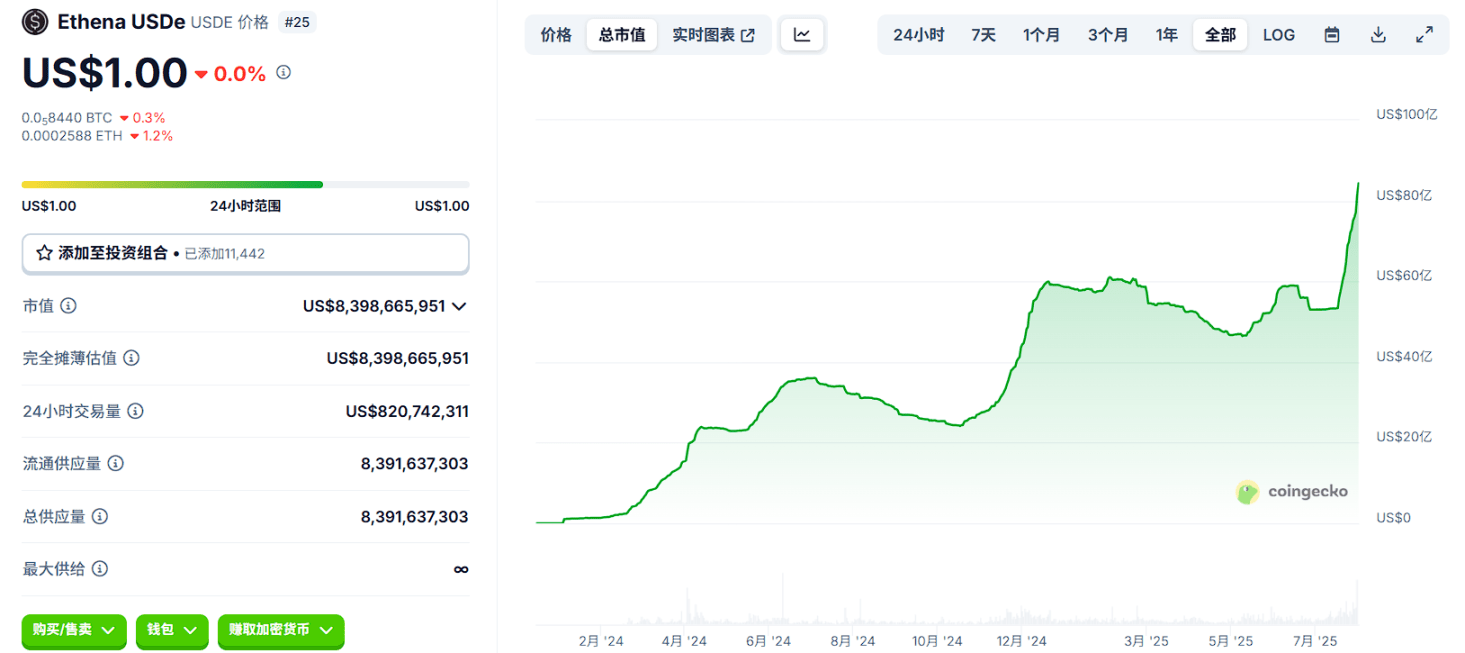
Its core mechanism is the 'delta-neutral' structure: on one hand, the protocol holds positions in assets like ETH, while on the other hand, it opens equivalent short positions in ETH perpetual contracts on centralized derivatives trading platforms. By combining spot and derivative hedges, USDe achieves a net exposure close to zero, thus stabilizing its price around $1.
sUSDe is the representative token that users receive after staking USDe into the protocol, featuring automatic yield accumulation. Its yield sources primarily include returns from the funding rate in ETH perpetual contracts and derivative yields from the underlying staked assets. This model aims to introduce a sustainable yield model for stablecoins while maintaining their price anchoring mechanism.
2. Introduction to Aave and Merkl: The collaborative system of lending protocol and incentive distribution mechanism
Aave is one of the longest-standing and most widely used decentralized lending protocols in the Ethereum ecosystem, dating back to 2017. It has promoted the popularization of DeFi lending systems in its early stages through the 'flash loan' mechanism and flexible interest rate model. Users can deposit crypto assets into the Aave protocol to earn interest or borrow other tokens by collateralizing assets, all without intermediaries. Currently, the total locked value (TVL) of the Aave protocol is approximately $34 billion, with nearly 90% deployed on the Ethereum mainnet, and the platform's native token AAVE has a total market cap of about $4.2 billion, ranking 31st on CoinMarketCap.
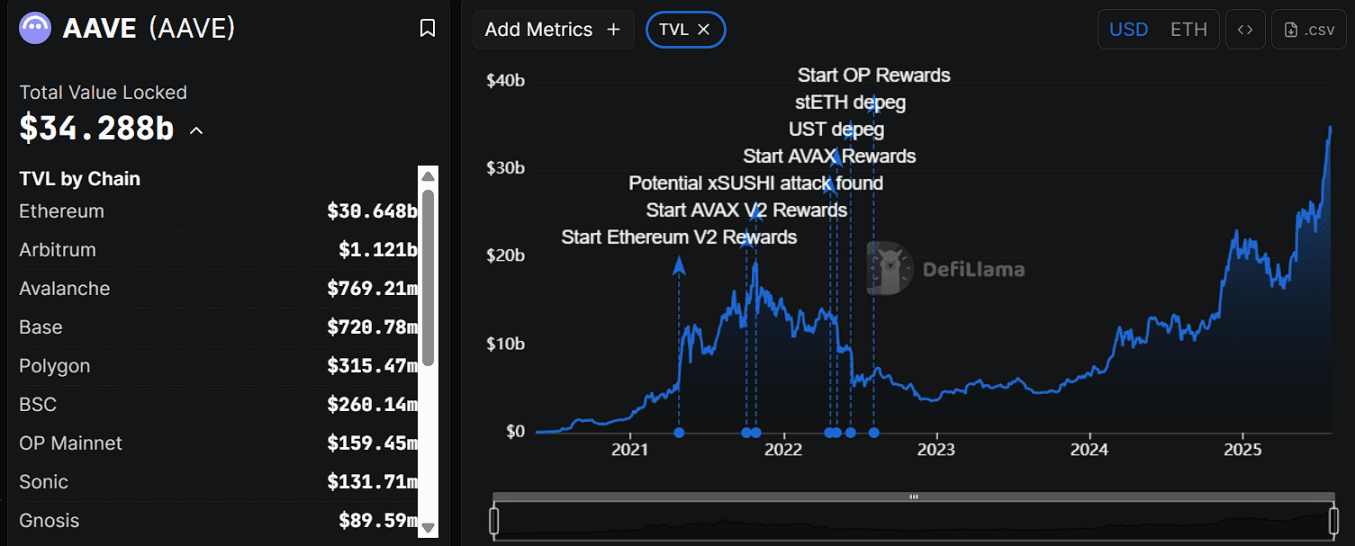
Merkl is a programmable incentive distribution platform launched by the Angle Protocol team, specifically designed to provide programmable and conditional incentive tools for DeFi protocols. By pre-setting parameters such as asset types, holding duration, liquidity contributions, etc., protocols can accurately set reward strategies and efficiently complete distribution processes. So far, Merkl has served over 150 projects and on-chain protocols, distributing a total of over $200 million in incentives, supporting multiple public chain networks including Ethereum, Arbitrum, and Optimism.
In this USDe incentive activity jointly initiated by Ethena and Aave, Aave is responsible for organizing the lending market, configuring parameters, and matching staked assets, while Merkl is responsible for setting reward logic and on-chain distribution operations.
In addition to the current USDe incentive collaboration, Aave and Merkl have previously formed a stable collaborative relationship in multiple projects, with one of the most representative cases being the joint intervention on the GHO stablecoin's de-pegging issue.
GHO is a native over-collateralized stablecoin launched by Aave, which can be minted by collateralizing assets like ETH and AAVE. Initially, due to limited market acceptance and insufficient liquidity, this currency quickly fell below its peg and has long hovered in the $0.94-$0.99 range, losing its price peg to the US dollar.
To address this deviation, Aave and Merkl established a liquidity incentive mechanism for the GHO/USDC and GHO/USDT trading pairs on Uniswap V3. The incentive rules aim for 'close to $1', granting higher rewards to liquidity providers concentrated around $1, thereby guiding trading depth to focus on the target range, thus forming a price stability wall on-chain. This mechanism has been effective in practice, successfully pushing the GHO price back up toward $1.
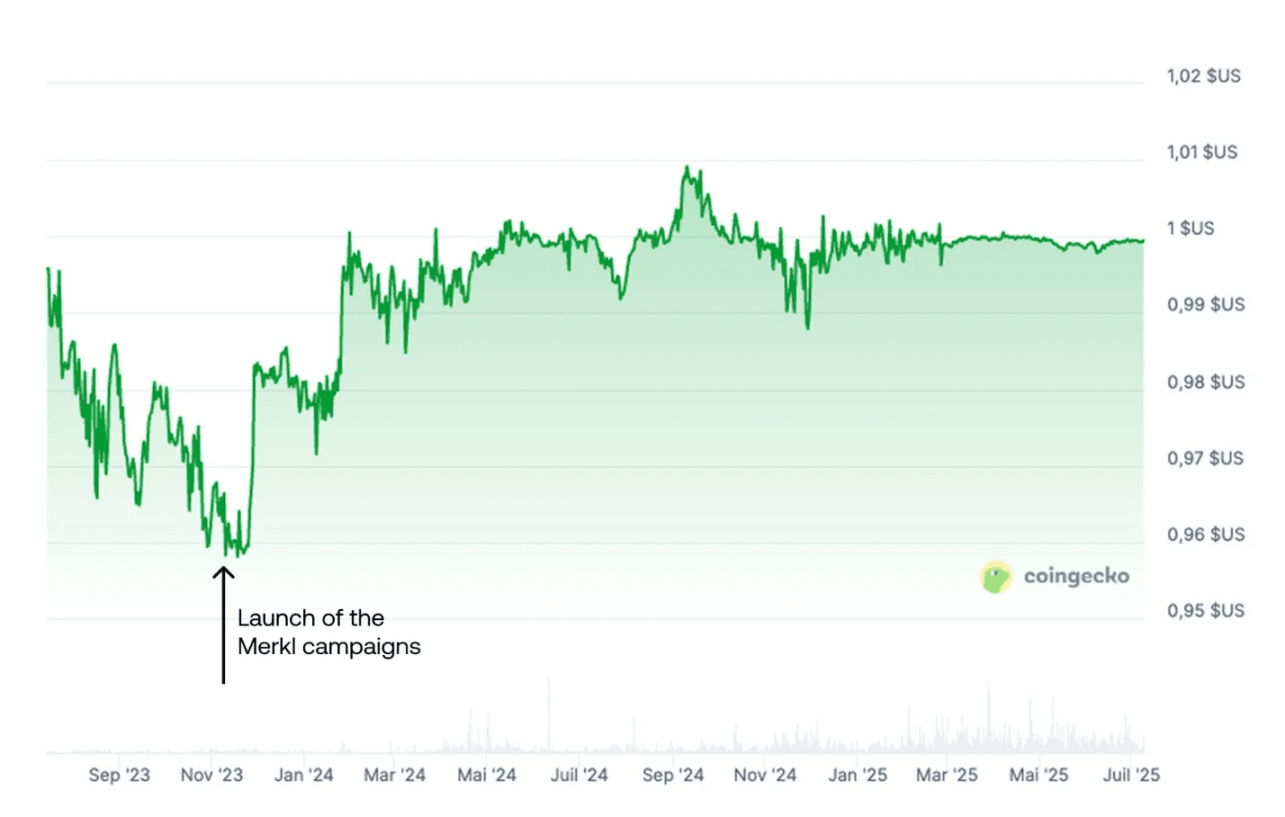
This case reveals the essential role of Merkl in the stabilization mechanism: through programmable incentive strategies, it maintains the liquidity density in key trading intervals on-chain, just like arranging 'subsidy vendors' at market price anchor points; only by consistently providing yields can a stable market structure be maintained. However, this also raises relevant questions: once the incentives are interrupted or the vendors withdraw, the support of the price mechanism may also fail.
3. Analysis of the source mechanism for 50% annualized yield
On July 29, 2025, Ethena Labs officially announced the launch of a feature module named 'Liquid Leverage' on the Aave platform. This mechanism requires users to simultaneously deposit sUSDe and USDe into the Aave protocol at a 1:1 ratio, forming a compound staking structure to obtain additional incentive rewards.
Specifically, qualified users can obtain three sources of yield:
1. Incentivized USDe rewards automatically distributed by Merkl (currently about annualized 12%);
2. The protocol yield represented by sUSDe, which comes from the funding fees of the delta-neutral strategy behind USDe and staking rewards;
3. Aave's base deposit interest depends on the current market funding utilization rate and pool demand.
The specific participation process for this activity is as follows:
1. Users can obtain USDe through the Ethena official website (ethena.fi) or decentralized exchanges (such as Uniswap);
2. Stake the held USDe on the Ethena platform to exchange for sUSDe;
3. Transfer an equal amount of USDe and sUSDe into Aave at a 1:1 ratio;
4. Enable the 'Use as Collateral' option on the Aave page;
5. After the system detects compliant operations, Merkl's platform automatically identifies addresses and regularly distributes rewards;
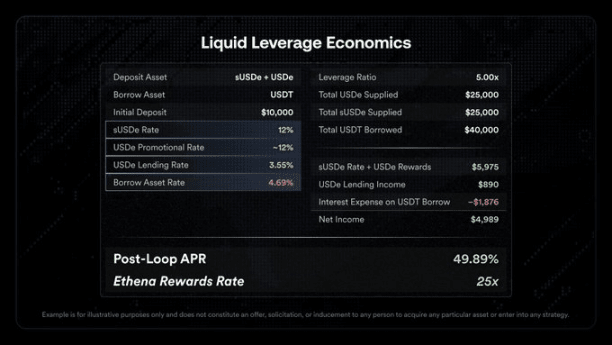
Official data, underlying computational logic breakdown:
Assumption: $10,000 principal, 5 times leverage, total borrowing of $40,000, with $25,000 collateralized to USDe and sUSDe respectively.

Leverage structure explanation:
The premise of this yield relies on the compound structure established by the 'lending – depositing – continuing to lend' cycle, where the initial principal is used for the first round of staking, and after borrowing funds, the next round of dual deposits of USDe and sUSDe is conducted. By leveraging 5 times, the total input reaches $50,000, thereby magnifying rewards and base yields.
Fourth, does the incentive plan reveal that USDe and GHO face the same structural dilemmas?
Although both USDe and GHO are stablecoins issued based on crypto asset staking, there are significant differences in their mechanisms. USDe maintains its peg through a delta-neutral structure, with historical prices stabilizing around $1, without experiencing severe deviations like GHO's de-pegging to $0.94, nor encountering liquidity crises similar to those relying on liquidity incentives to restore prices. However, this does not mean USDe is completely immune to risks; its hedging model has inherent vulnerabilities, especially during extreme market fluctuations or when external incentives are withdrawn, potentially facing stability shocks similar to GHO.
Specific risks are reflected in the following two aspects:
1. Funding rates are negative; protocol yields decline or even become negative:
The main yield of sUSDe comes from the LST yields obtained from staked assets like ETH and the positive funding rates established on centralized derivatives platforms for ETH short perpetual contracts. Currently, market sentiment is positive, with longs paying shorts' interest, maintaining positive returns. However, once the market turns weak, with an increase in shorts and negative funding rates, the protocol will need to pay additional fees to maintain hedged positions, which will reduce yields, potentially turning negative. Although Ethena has an insurance fund buffer, whether it can cover negative yields in the long term remains uncertain.
2. Incentive termination → Promotional Rate 12% yield disappears directly
The Liquid Leverage activity currently being executed on the Aave platform only temporarily offers additional USDe rewards (annualized about 12%). Once the incentives end, the actual yield held by users will revert to the native yield of sUSDe (funding fees + LST yields) and the deposit interest rate on the Aave platform, potentially declining to the range of 15-20%. If under high leverage (e.g., 5 times), the borrowing rate of USDT (currently at 4.69%) will further compress the yield space. In more severe cases, in extreme environments where funding is negative and interest rates rise, users' net yield may be completely eroded or even turn negative.
If the incentives terminate, ETH drops, and the funding rate turns negative simultaneously, the delta-neutral yield mechanism relied upon by the USDe model will face substantial impact, and sUSDe yields may drop to zero or even become negative. If accompanied by massive redemptions and selling pressure, the price anchoring mechanism of USDe will also face challenges. This 'multiple negative overlay' constitutes the most critical systemic risk in Ethena's current structure and may be the deep-seated motivation behind its recent high-intensity incentive activities.
Fifth, will the Ethereum price increase stabilize the structure?
Due to USDe's stability mechanism relying on the spot staking of Ethereum assets and derivatives hedging, its liquidity pool structure faces systemic withdrawal pressure during rapid ETH price increases. Specifically, when the ETH price approaches the market's expected high, users tend to redeem staked assets early to realize profits or shift to other assets with higher returns. This behavior triggers a typical 'ETH bull market → LST outflow → USDe contraction' chain reaction.
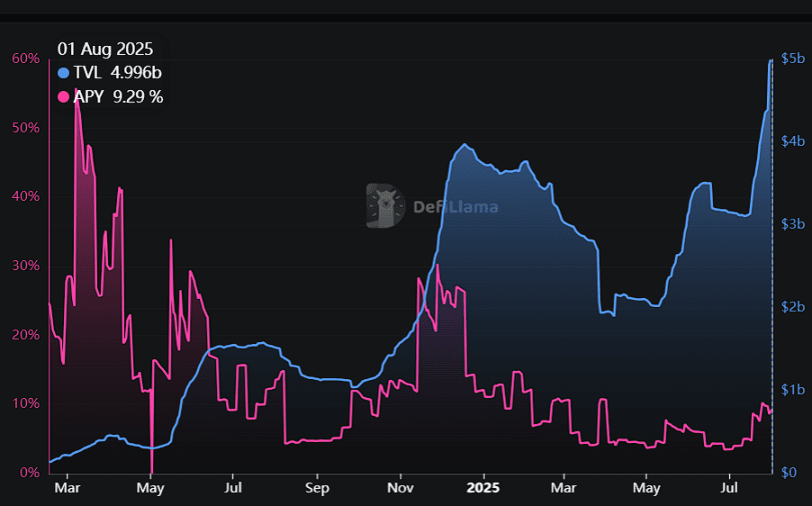
From DeFiLlama data, it can be observed that the TVL of USDe and sUSDe both declined during the spike in ETH prices in June 2025, and there was no increase in annualized yields (APY) accompanying the price rise. This phenomenon contrasts with the previous bull market (end of 2024): at that time, after ETH reached its peak, the TVL gradually declined, but the process was relatively slow, and users did not collectively redeem staked assets early.
In the current cycle, TVL and APY are both declining, reflecting an increase in market participants' concerns about the sustainability of sUSDe yields. When price fluctuations and changes in funding costs bring potential negative yield risks to the delta-neutral model, user behavior shows higher sensitivity and reaction speed, with early exits becoming the mainstream choice. This phenomenon of capital withdrawal not only weakens USDe's expansion ability but also further amplifies its passive tightening characteristics during the ETH rally.
Conclusion:
In summary, the current annualized yield of up to 50% is not a norm for the protocol, but rather a result of multiple external incentives (Merkl airdrop + Aave linkage) driving the phenomenon. Once ETH prices fluctuate at high levels, incentives cease, and funding rates turn negative, the delta-neutral yield structure relied upon by the USDe model will face pressure, with sUSDe yields potentially converging rapidly to 0 or turning negative, thus impacting the stability anchoring mechanism.
Recent data shows that the TVL of USDe and sUSDe has declined synchronously during the ETH rally phase, and APY has not increased in tandem; this 'withdrawal during the rise' phenomenon indicates that market confidence is beginning to price in risks ahead of time. Similar to the 'pegging crisis' faced by GHO, the current liquidity of USDe largely relies on continuous subsidized stabilization strategies.
When this incentive game ends, and whether it can provide the protocol with a sufficient structural resilience adjustment window, may become the key test for whether USDe truly possesses the potential of being the 'third pole of stablecoins'.
